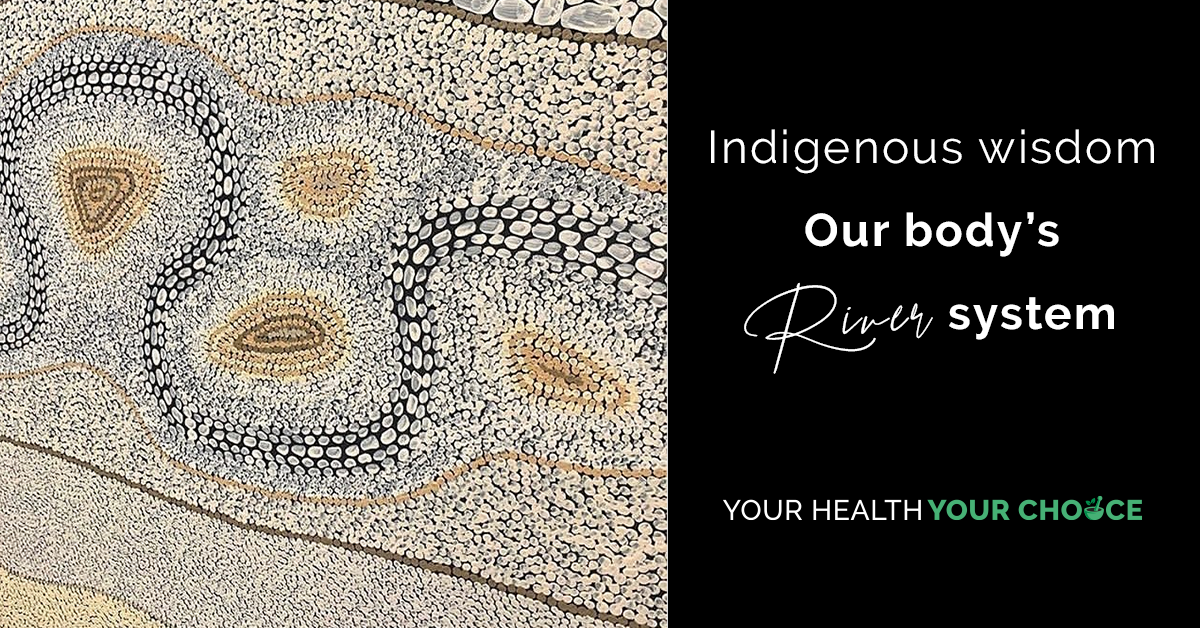Our immune system, our river system – indigenous wisdom

The beautiful artwork is by Kurun Warun: Dry Riverbed Camp. Sourced from @japingka_
This month we welcome our guest author, Joanna Nation who is based in Melbourne. In her practice, Joanna encompasses many styles of Yoga combined with Ayurvedic principles, Qi Gong and Traditional Chinese Medicine, aspects of counselling with a bio-psycho-social focus along with Western Herbal Medicine.
Joanna is a keen advocate for Traditional and Complementary Medicine and would like to see it government subsidised so that marginalised communities have equal opportunity to access it. She believes the government needs to do more in providing incentives for broader access to effective, preventative healthcare.
In this article, Joanna describes how she was inspired by Tyson Yunkaporta’s brilliant book, Sand Talk: How indigenous thinking can save the world. This book explores how the immune system beautifully reflects a river system and other abstract modes of thought processes, useful for many of our modern issues.
Our immune system, our river system
Indigenous people have thrived in mutual connection with this land for thousands of years, we all have so much to learn from this connection. For some time, I have felt and heard the deep injustices of our Indigenous people, and it is very evident to me that the capitalist and patriarchal paradigm we are conditioned to work within does not benefit everyone. If we want to learn about congruent relationships with the environment, with people, and with our health, we may find the answers within the cultures that have existed before colonialism.
A yearning to learn from Indigenous people formed the impetus to read this book.
Yunkaporta uses the Aboriginal custom of drawing images in the ground (hence the title Sand talk) to sequence the stories, or yarns, as chapters. The whole book was thought-provoking, but it was the chapter ‘Lemon for Headaches’ that I really got excited about as Yunkaporta delved into food, health and healthcare.
He draws on traditional customs and describes different plants as medicine (as a herbalist this piqued my interest) however he emphasises that ‘holistic’ health is a way of living and looking at the world in its state of constant change and evolution, not just one plant for one condition definitively.
Throughout my health science education (and in much advertising for flu and cold medicine on TV) the immune system is often described as an army with soldiers fighting the ‘enemy’, but in Yunkaporta’s book, he describes a more dynamic framework based on an Australian river system:
“There are many connected species that deal with dead animals in a river system. These are species in the water (innate immunity) and species in the land (adaptive immunity). A kangaroo carcass (pathogen) on the river bank is cleaned up by land species like crows, flies and ants, while parts of the kangaroo that fall into the river are cleaned up by water species like eels and yabbies to prevent pollution (bacterial infection)…”
His description of the ‘inflammatory mediators’ as certain water creatures, feasting on the kangaroo carcass ‘pathogen’ and sending out signals for others to join, emphasises a more effectual and interactive scenario compared to an army of soldiers, generals and invaders.
“The small brown yabbies (dendritic and mast cells) are always crawling about looking for meat. They are the first on the scene, and their excitement on finding the meat signals the blue-claw yabbies (neutrophils) to join the feast.
They need help breaking down the larger parts. A signal is given by the flowering silly oak tree… for the eels to feast and get fat. So, the eels (macrophages/ eosinophils) arrive on the scene then and help clear the rotting meat (infection) from the river”
This Indigenous way of thinking extends to the adaptive immune system, comprised of ant species as the specialised cells,
“On the riverbank, the highly adaptive ants (antigen-presenting cells) have been busy too.
Foraging ants (helper T-cells) send out scent signals that let other ants and species of carrion eaters know there is a dead animal on the bank.
The queen ants (regulatory T-cells) moderate adaptive responses with the ant nests, also with scent signals, responding to dangers like rising water levels (compromised immune system) or opportunities like the right air temperature, to begin mating and to form new nests to feed on different dead animals along the river (diverse pathogens) in the dry season when more animals are dying there….”
And even manages to weave in metaphor of our acquired immunity, with memory cells as the ant eggs helping to fight the second occurrence of pathogens,
“The ants also mate with flying female ants who lay eggs (memory cells) for a new generation of ants who all carry the same knowledge of how to keep the river system healthy by dealing with future carcasses (the pathogens you are now immune to).”
Yunkaporta goes on to say how understanding biological networks appropriately means finding a way to personally belong to that system.
I was reminded that the reductionist method of test-tube (in-vitro) scientific studies tend to over-simplify and miss the dynamic framework of individual health and our unique body systems.
Just as nature is constantly evolving and advancing to adapt as needed, our lens of health should require that we explore the interrelated variables of each human we are working with in an ever changing environment– I believe this is what treating holistically really means.
« Return to News & Features
